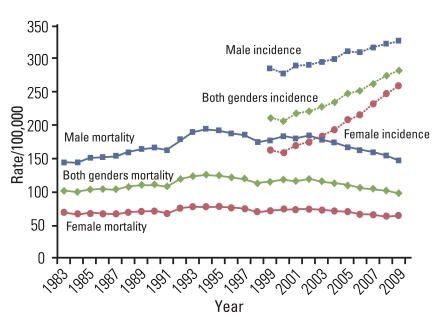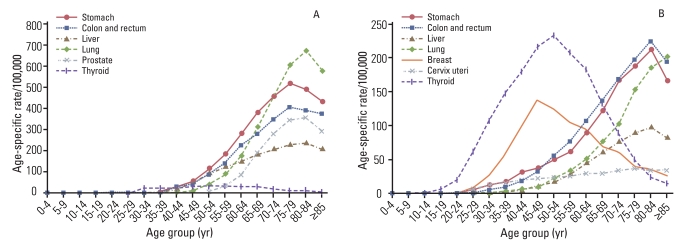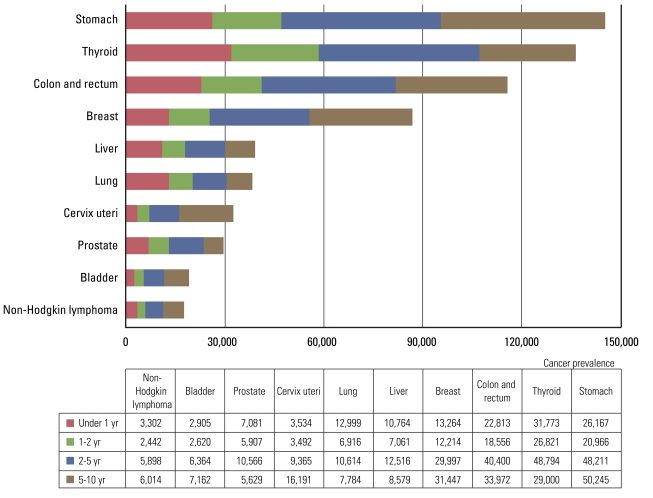Cancer Res Treat.
2012 Mar;44(1):11-24.
Cancer Statistics in Korea: Incidence, Mortality, Survival, and Prevalence in 2009
- Affiliations
-
- 1The Korea Central Cancer Registry, Division of Cancer Registration and Surveillance, National Cancer Center, Goyang, Korea. shpark@ncc.re.kr
- 2National Cancer Control Institute, National Cancer Center, Goyang, Korea.
Abstract
- PURPOSE
This study overviews nationwide cancer statistics, including incidence, mortality, survival, and prevalence, and their trends in Korea based on 2009 cancer incidence data.
MATERIALS AND METHODS
Incidence data from 1993-2009 were obtained from the Korea National Cancer Incidence Database, and vital status was followed through 31 December 2010. Mortality data from 1983-2009 were obtained from Statistics Korea. Crude rates and age-standardized rates for incidence, mortality, and prevalence; and relative survival were calculated.
RESULTS
In total, 192,561 cancer cases and 69,780 cancer deaths were observed during 2009, and 808,503 10-year cancer prevalent cases occurred in Korea as of 1 January 2010. The incidence rate for all cancers combined showed an annual increase of 3.3% from 1999 to 2009.
CONCLUSION
Stomach, liver and cervical cancers have been decreasing and thyroid, breast and colorectal cancers have been increasing at large. In particular, in 2009, colorectal cancer became the third most common cancer in females and for the first time ranked higher than stomach cancer, which had been the long-standing common cancer in Korea. While overall cancer incidence has been rapidly increasing in Korea, age-standardized cancer mortality rates have been declining since 2002, and cancer survival has been improving.
MeSH Terms
Figure
Reference
-
1. Statistics Korea, 2011 [Internet]. 2011. cited 2012 Jan 16. Daejeon: Statistics Korea;Available from: http://kostat.go.kr .2. Jung KW, Park S, Kong HJ, Won YJ, Lee JY, Park EC, et al. Cancer statistics in Korea: incidence, mortality, survival, and prevalence in 2008. Cancer Res Treat. 2011; 43:1–11. PMID: 21509157.
Article3. Won YJ, Sung J, Jung KW, Kong HJ, Park S, Shin HR, et al. Nationwide cancer incidence in Korea, 2003-2005. Cancer Res Treat. 2009; 41:122–131. PMID: 19809561.
Article4. Shin HR, Won YJ, Jung KW, Kong HJ, Yim SH, Lee JK, et al. Nationwide cancer incidence in Korea, 1999~2001: first result using the national cancer incidence database. Cancer Res Treat. 2005; 37:325–331. PMID: 19956367.
Article5. Ajiki W, Tsukuma H, Oshima A. Index for evaluating completeness of registration in population-based cancer registries and estimation of registration rate at the Osaka Cancer Registry between 1966 and 1992 using this index. Nihon Koshu Eisei Zasshi. 1998; 45:1011–1017. PMID: 9893469.6. Fritz A, Percy C, Jack A, Shanmugaratnam K, Sobin L, Parkin DM, et al. International classification of diseases for oncology. 2000. 3rd ed. Geneva: World Health Organization.7. World Health Organization. Manual of the international statistical classification of diseases, injuries, and causes of death. 1992. 10th rev. Geneva: World Health Organization.8. Segi M. Cancer mortality for selected sites in 24 countries (1950-1957). 1960. Sendai: Tohoku University School of Medicine.9. Altekruse SF, Kosary CL, Krapcho M, Neyman N, Aminou R, Waldron W. SEER cancer statistics review, 1975-2007. 2010. Bethesda, MD: National Cancer Institute.10. SEER*Stat Program, version 6.6.1 [Internet]. National Cancer Institute. 2011. cited 2011 Jan 14. Bethsda, MD: National Cancer Institute;Available from: http://seer.cancer.gov/seerstat/ .11. Ederer F, Heise H. Instructions to IBM programmers in processing survival computations. Methodological note No. 10. 1959. Bethesda, MD: National Cancer Institute.12. Dickman P [Internet]. cited 2009 Apr 14. Stockholm: PaulDickman.com;Available from: http://www.pauldickman.com .13. Davies L, Welch HG. Increasing incidence of thyroid cancer in the United States, 1973-2002. JAMA. 2006; 295:2164–2167. PMID: 16684987.
Article14. Enewold L, Zhu K, Ron E, Marrogi AJ, Stojadinovic A, Peoples GE, et al. Rising thyroid cancer incidence in the United States by demographic and tumor characteristics, 1980-2005. Cancer Epidemiol Biomarkers Prev. 2009; 18:784–791. PMID: 19240234.
Article15. Curado MP, Edwards B, Shin HR, Stom H, Ferlay J, Heanue M. Cancer incidence in five continents, vol. 9. 2007. Lyon: IARC.16. Jung KW, Yim SH, Kong HJ, Hwang SY, Won YJ, Lee JK, et al. Cancer survival in Korea 1993-2002: a population-based study. J Korean Med Sci. 2007; 22(Suppl):S5–S10. PMID: 17923755.
Article
- Full Text Links
- Actions
-
Cited
- CITED
-
- Close
- Share
- Similar articles
-
- Cancer Statistics in Korea: Incidence, Mortality, Survival, and Prevalence in 2008
- Cancer Statistics in Korea: Incidence, Mortality, Survival, and Prevalence in 2013
- Cancer Statistics in Korea: Incidence, Mortality, Survival, and Prevalence in 2012
- Cancer Statistics in Korea: Incidence, Mortality, Survival, and Prevalence in 2011
- Cancer Statistics in Korea: Incidence, Mortality, Survival, and Prevalence in 2016






